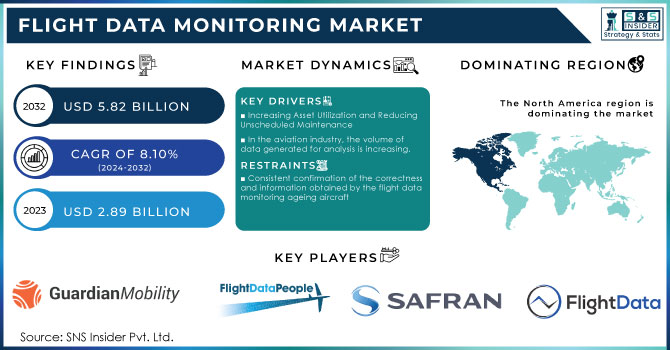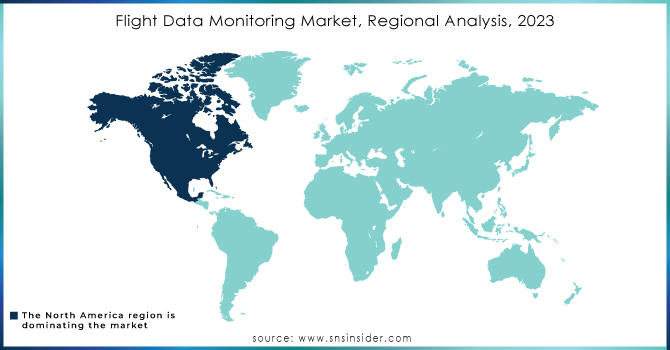Flight Data Monitoring Market Report Scope & Overview:

To get more information on Flight Data Monitoring Market - Request Free Sample Report
The Flight Data Monitoring Market Size was valued at USD 2.89 billion in 2023, expected to reach USD 5.82 billion by 2032 with an emerging CAGR of 8.10% over the forecast period 2024-2032.
For data gathering and processing, flight data monitoring systems necessitate significant investments and specialized personnel. This sometimes puts pressure on fleet operators to minimize costs in other, equally critical areas of investment. However, because flight data monitoring is one of the critical activities, deferring the activity is not an option. As a result, industry participants are providing flight data monitoring services to consumers in order to save them significant time and money. Service providers also supply professional resources to improve flight performance and operations. Flight data monitoring services are broadening their geographical reach and offering to small airlines and fleet operators.
Flight data monitoring and analysis (FDMA) is the process of evaluating recorded flight data in order to improve flight safety and maintenance. Currently, flight data monitoring and analysis are used for enhancing flight crew performance, fleet operator maintenance areas, air carrier training programme and operating programme, air traffic control procedures, and aircraft operations and design to run a successful aviation organization, in addition to safer flight operations. FDMA provides numerous benefits, including reduced fuel usage, fewer deadly accidents, less wasteful maintenance and repairs, and enhanced pilot training program.
MARKET DYNAMICS
KEY DRIVERS
-
Increasing Asset Utilization and Reducing Unscheduled Maintenance
-
In the aviation industry, the volume of data generated for analysis is increasing.
RESTRAINTS
-
Consistent confirmation of the correctness and information obtained by the flight data monitoring ageing aircraft
OPPORTUNITIES
-
In the aviation industry, there is an increasing demand for real-time analytics.
-
FDM can assist in monitoring fuel use for increased flying efficiency, lowering maintenance costs.
CHALLENGES
-
Assurance of the Quality and Accuracy of Flight Data Monitoring Received Information
-
Cost-Effective Maintenance
IMPACT OF COVID-19
Since the advent of the global corona virus pandemic at the end of 2019, followed by the spread in international locations in 2020, the flight data monitoring market has been one of the most affected. Both the domestic and foreign markets that promote the travel and tourism business are experiencing major functional concerns that are likely to impede the market's ability to overcome the challenges that have been driving since the pandemic's outbreak.
Market participants are looking for dynamics that would assist the market in covering losses experienced throughout the projected period, which will finish in 2028. The flight data monitoring market share is diminishing, and as a result, there is a significant shortage of money, technology, and investments to fulfil the industry's evolving needs, as well as the need for the target audience, which is dispersed around the globe.
The growing demand for enhanced situational awareness for efficient airline operations, the need to reduce the cost of unscheduled maintenance, the growing volume of data generated by the aviation industry, and the increase in aircraft deliveries are all expected to drive the flight data monitoring market.
According to estimates, the FDM service category will lead the flight data monitoring market. Factors such as increased aircraft deliveries and desire for enhanced airline operational efficiency are supporting the expansion of the FDM service market.
The on-ground segment is predicted to lead the flight data monitoring market throughout the forecast period, based on solution type. The on-ground segment is being driven by the rising usage of ground-based flight data monitoring and analysis software.
The fleet operators sector is expected to account for a significant part of the flight data monitoring market. The growing fleet size of APAC's major airlines is propelling the flight data monitoring industry.
The fleet operators segment led the APAC flight data monitoring systems market in terms of end user. An aircraft fleet operator owns one or more aeroplanes that are not rented or leased to anyone else. The flight data monitoring system is a powerful tool for fleet operators to use to monitor and improve operational safety. The system is an essential component of a fleet operator's management system, serving as a primary data source for monitoring operational safety. The National Aviation Authority of the EASA Member State seeks access to the safety meetings where the flight data monitoring events and trends are discussed in order to evaluate how the data is used and analysed by the fleet operator.
KEY MARKET SEGMENTATION
By Solution Type
-
On Board
-
On Ground
By Component
-
FDM Service
-
FDM System
-
FDM Software
By End User
-
Fleet Operators
-
Drone Operators
-
FDM Service Providers
-
Investigation Agencies
REGIONAL ANALYSIS:
The North American market is predicted to account for the majority of revenue and to maintain its dominance during the projection period. The presence of major competitors, as well as the high number of air transport passengers, are driving the expansion of the target market in this region. Over the projection period, the Asia Pacific market is expected to grow at the fastest rate in terms of revenue, followed by markets in Europe, Latin America, and the Middle East and Africa. Over the projected period, the growing aviation sector, particularly in emerging economies such as China and India, is expected to drive expansion in the flight data monitoring market.

Need any customization research on Flight Data Monitoring Market - Enquiry Now
REGIONAL COVERAGE:
-
North America
-
USA
-
Canada
-
Mexico
-
-
Europe
-
Germany
-
UK
-
France
-
Italy
-
Spain
-
The Netherlands
-
Rest of Europe
-
-
Asia-Pacific
-
Japan
-
south Korea
-
China
-
India
-
Australia
-
Rest of Asia-Pacific
-
-
The Middle East & Africa
-
Israel
-
UAE
-
South Africa
-
Rest of Middle East & Africa
-
-
Latin America
-
Brazil
-
Argentina
-
Rest of Latin America
-
KEY PLAYERS
The Key Players are Flight Data Services Ltd, NeST Aerospace Pvt. Ltd, Safran Electronics & Defense, FlightDataPeople, Guardian Mobility Corporation, Scaled Analytics Inc, Helinalysis Ltd, French Flight Safety, Teledyne Controls, Aerobytes Ltd & Other Players
| Report Attributes | Details |
| Market Size in 2022 | US$ 2.89 billion |
| Market Size by 2030 | US$ 5.82 billion |
| CAGR | CAGR of 8.10% From 2024 to 2032 |
| Base Year | 2022 |
| Forecast Period | 2024-2032 |
| Historical Data | 2020-2022 |
| Report Scope & Coverage | Market Size, Segments Analysis, Competitive Landscape, Regional Analysis, DROC & SWOT Analysis, Forecast Outlook |
| Key Segments | • By Solution Type (On Board, On Ground) • By Component (FDM Service, FDM System, FDM Software) • By End User (Fleet Operators, Drone Operators, FDM Service Providers, Investigation Agencies) |
| Regional Analysis/Coverage | North America (USA, Canada, Mexico), Europe (Germany, UK, France, Italy, Spain, Netherlands, Rest of Europe), Asia-Pacific (Japan, South Korea, China, India, Australia, Rest of Asia-Pacific), The Middle East & Africa (Israel, UAE, South Africa, Rest of Middle East & Africa), Latin America (Brazil, Argentina, Rest of Latin America) |
| Company Profiles | Flight Data Services Ltd, NeST Aerospace Pvt. Ltd, Safran Electronics & Defense, FlightDataPeople, Guardian Mobility Corporation, Scaled Analytics Inc, Helinalysis Ltd, French Flight Safety, Teledyne Controls, Aerobytes Ltd |
| Key Drivers | • Increasing Asset Utilization and Reducing Unscheduled Maintenance • In the aviation industry, the volume of data generated for analysis is increasing. |
| Market Opportunities | • In the aviation industry, there is an increasing demand for real-time analytics. • FDM can assist in monitoring fuel use for increased flying efficiency, lowering maintenance costs. |

